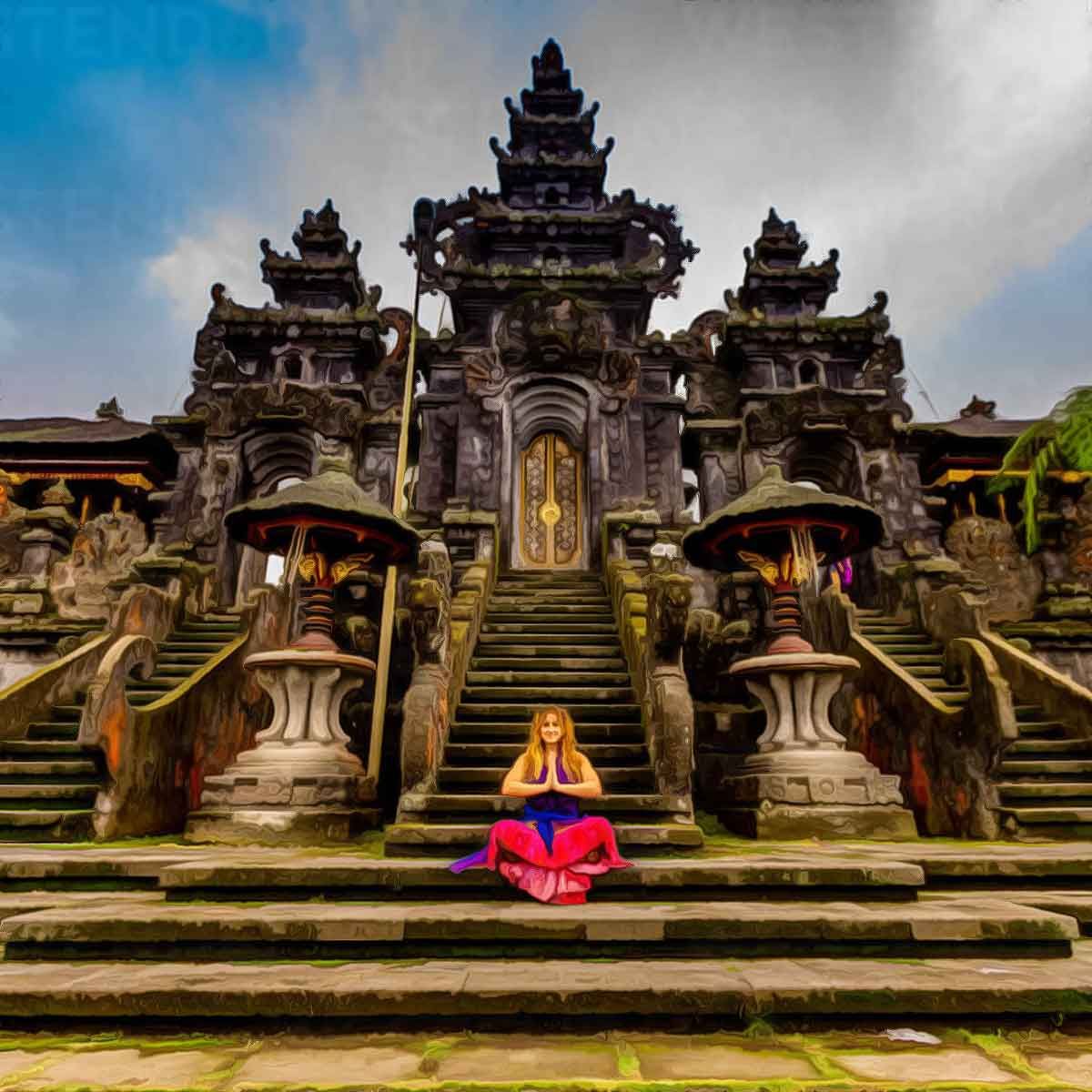More Coverage
Twitter Coverage
Satyaagrah
Written on
Satyaagrah
Written on
Satyaagrah
Written on
Satyaagrah
Written on
Satyaagrah
Written on
Join Satyaagrah Social Media
"Restoration & hope is available each time you turn to Sanatan": Besakih Mandir on slopes of Mount Agung in Eastern Bali is largest, holiest & important temple of Hinduism in Indonesia for history of its culture, archeology, architecture, social & economy

Hinduism, as the world’s oldest religion, has traveled all across the world since the dawn of time. This polytheistic religion is one of the most well-known and widely practiced religions in the world, particularly in Southeast Asia. Even while each culture interprets religion differently, the essential beliefs remain the same. The Besakih temple in Bali is an excellent example of this.
|
Jakarta - The PUPR Ministry through the Directorate General of Human Settlement is currently managing the Pura Agung Besakih area in Karangasem, Bali as an effort to protect the cultural heritage area which is the center of Hindu worship in Bali as well as a world-class tourist destination.
PUPR Minister Basuki Hadimuljono said the physical work on area planning would not touch the Besakih Temple main building area which is used as a place of worship.
"The most important thing about the arrangement of this area is to increase the comfort of visitors who worship and travel. Because according to information, when there is a big ceremony the conditions will be very crowded. For this reason, different entry and exit routes will be made, so there is no congestion, including road circulation for vehicles. will be arranged," said Minister Basuki.
Pura Agung Besakih, which is located at the foot of Mount Agung in Rendang District, Karangasem Regency, is the largest and holiest temple in Bali and is the main spiritual service center for Hindus in Bali and even in Indonesia to perform prayers. The combination of the landscape and architecture of the beautiful temple buildings also makes the Besakih Temple Area one of the world-class tourist destinations.
Director of Building Management for the Ministry of PUPR Boby Ali Azhari said that the arrangement for the Besakih Temple area began in August 2021 and is planned to end in December 2022.
"The arrangement of the Pura Agung Besakih area is carried out with a design and build mechanism using the state budget of IDR 378.4 billion. Physical progress has now reached 54.3%," said Boby while directly observing the progress of the construction of the Besakih Temple Area, Saturday (10/9/2022).
This area arrangement activity was carried out by PT Pembangunan Perumahan (PP) as the implementing contractor and PT Ciriajasa Cipta Mandiri as a Construction Management consultant with a Multi Years Contract (MYC) 2021-2022.
The arrangement was carried out in two areas, namely the Manik Mas Area and the Becingah Area. The arrangement of the Manik Mas area includes a 5-storey parking building, 20 large kiosk units, 36 small kiosk units, Bale Pesandekan, Melanting Temple, Anjung Pandang building, toilets and an access road. While the arrangement of the Bencingah Area includes the construction of 194 large kiosk units, 140 small kiosk units, Bale Pesandekan, Bale Gong, Courtyard, children's play area, toilets and parking area. (Yul)
|
Besakih Temple – The Quintessential Balinese Architectural structure
Besakih Temple is a vast complex of more than 86 clan temples and shrines on the south-western slopes of Mount Agung – is commonly referred to as Bali’s “mother temple.”Its great elevation provides breathtaking views of the area, including rice farms, hills, mountains, and streams.
Bali’s Besakih Temple is the largest and holiest of the island’s temples.
Because of its significant religious practice and the hundreds, if not thousands, of temples that dot the island, Bali has been dubbed the “island of the gods.”
Three significant temples dedicated to the Hindu trinity may be seen in Pura Besakih. Pura Penataran Agung at the central is decorated with white colors for Shiva, the destructive; Pura Kiduling Kreteg placed at the right is decorated with red colour for Brahma, the originator; and Pura Batu Madeg is decorated with black colours for Vishnu, the sustainer.
The centre stone, known as batu ngadeg, is housed at the shrine of Meru Tumpang Sebelas at Pura Batu Madeg. Vishnu is said to have appeared at this location. The Persatuan temple (quadrangular-shaped with two lines of 16 poles) is located in the courtyard of Pura Batu Madeg, in front of Meru Tumpang Sebelas, and shows how Vishnu’s light interacts with the world.
A centre stone at Pura Batu Madeg indicates that the Pura Besakih area has been venerated as a sacred spot from ancient times. During his isolation in the seventh century, a Hindustani monk got revelations to create shelters for humanity. During this time, many of his followers died as a consequence of disease and accidents. It was given the name “Basuki” in honour of the dragon god “Naga Besukian,” who is thought to reside atop Mount Agung. Eventually, the name was changed to ‘Besakih.’
During the Majapahit Empire’s conquest of Bali in 1343, other shrines were gradually built, and Pura Besakih was made the main temple. Due to earthquakes in 1917 and Mount Agung’s series of eruptions in 1963, Pura Besakih has undergone various repairs since then. According to locals, the lava flow spared Pura Besakih because the gods wanted to demonstrate their power without destroying the holy structure.
The four temples in the complex reflect the four gods who preside over their respective compass points. Pura Batu Madeg lies to the north, Pura Kiduling Kreteg lies to the south, Pura Gelap lies to the east, and Pura Ulun Kulkul lies to the west.
The Besakih Temple complex is built in the style of Bali’s iconic Balinese architecture. Balinese architecture is a tropical architectural style native to Asia that has a special flare for being in sync with nature. The design is based on the well-known Indonesian island of Bali, which attracts a huge number of foreign visitors who are drawn to the province’s heritage, laid-back way of life, and plenty of environmental assets.
Thanks to its miles of magnificent beaches, picturesque mountains, and calm countryside, Bali has become one of the world’s top attractions and has had a big impact on the world of architecture and design.
The architectural design’s concepts concentrate on Hinduism, spatial order, and communal social interactions.
- Tri Hata Karana – Creating equilibrium and harmony between the three components of life: the man, the natural world, and the divine.
- Tri Mandala – zoning and space partition rules
- Sanga Mandala – a system of principles for zoning and space partitioning based on directions.
- Tri Angga – an idea or hierarchy that exists between many realms.
- Tri Loka – akin to Tri Anna but with a different realm system.
- Asta Kosala Kosali – For symbols, shrines, stages, and units of measurement, there are eight architectural design standards to follow.
- Arga Segara — holy axis connecting mountain and sea
Balinese architecture is based on these beliefs and focuses on four strengths:
- A good ventilation system – large windows are employed in Balinese homes and luxury villas to give full attention to air movement. A big open area is also formed between the roof and the wall.
- A Firm Foundation – The human body, according to the Tri Loka concept, is akin to a building, and a structure with a firm foundation, such as human feet, is immensely powerful.
- A Large Yard – A traditional Balinese house or villa must have a large yard to commune with the natural surroundings, which is founded on the philosophy of being in harmony with nature.
- A high wall conceals the dwelling from public view, offering privacy and protection from other people, as well as warding off black magic and evil spirits.
The Besakih Temple plays an important role in today’s social and urban fabric, uniting the rich cultural history with the modern generation. Not only because the pilgrimage site attracts visitors from all over the world, but also because it offers a pleasant contrast between new and heritage structures in the Balis structural skyline. This contrast exemplifies how a country can progress while remaining linked to its roots.
To this day, the Besakih temple is an important part of Bali’s culture, celebrating the city’s people’s unity regardless of caste or gender. The structure is a symbol of hope and unity, and it is a popular tourist attraction in Bali.
|
Besakih Temple as a world heritage
Besakih Temple is a place of worship for both Hindus in Bali and Indonesia. Viewed from the point of view of cultural resources, Besakih Temple has high importance for history, culture, archeology, architecture, social, economy, and scientific development. Given the important value and potential of Besakih Temple, the Indonesian government is trying to preserve Besakih Temple by nominating it on the world cultural heritage list. Moreover, Besakih Temple fulfills the criteria and requirements as a world cultural and natural heritage from UNESCO. The central government's attempt to nominate Besakih Temple was not approved by the local government and some Balinese Hindus.
They think that if the Besakih Temple is nominated as a world cultural heritage then the religious activities that have been carried out for centuries at the temple will be disrupted. In addition, the sanctity of Besakih Temple will be reduced. Differences of opinion between the central government and local governments and some Balinese Hindu communities naturally lead to conflict. In this thesis, the background that raises the issue of Besakih's nomination as a world cultural heritage will be disclosed.
In accordance with the problems faced to be able to understand the problem in more depth, a conflict analysis is carried out. From the studies conducted by interviews, participatory observation, and the literature review in this thesis reveals some of the main issues underlying the problem of the rejection of the Besakih Temple's nomination as a world cultural heritage by the local government and some Balinese Hindu communities.
Things that were successfully disclosed included the reasons for the central government's nomination of Besakih Temple, the reasons for the rejection by the local government and some Balinese Hindus, the history of the conflict, conflict maps, and the role of the community in both the management of Besakih Temple and the nomination process. In addition, this thesis also proposes suggestions for conflict resolution and management efforts in the future. the reasons for the rejection by the local government and some Balinese Hindus, the history of the conflict, maps of the conflict, and the role of the community in both the management of the Besakih Temple and the nomination process.
In addition, this thesis also proposes suggestions for conflict resolution and management efforts in the future. the reasons for the rejection by the local government and some Balinese Hindus, the history of the conflict, maps of the conflict, and the role of the community in both the management of the Besakih Temple and the nomination process. In addition, this thesis also proposes suggestions for conflict resolution and management efforts in the future.
Pura Besakih is the most sacred Hindu temple in Bali as well as in Indonesia. The temple is also one of the invaluable heritages for the whole Indonesian nation. This living monument has important value for history, culture, archaeology, architecture, social, economy, and the development of science. Therefore, in order to preserve the heritage, the Central Government of the Republic of Indonesia made an effort to put Pura Besakih in the World Heritage List. In addition, the government considered that the temple will meet the criteria and qualifications required by UNESCO to be listed as the world heritage of culture and nature.
However, the Government’s effort to nominate the temple was not approved by Bali Provincial Government and some Hindu Balinese communities. They assumed if the temple was listed as the world cultural heritage, their religious activities which have been carried our for centuries would be annoyed and it would spoil the temple as a sacred place of Hinduism. Such different perspective between the Central Government in one hand and the Bali Provincial Government and some Hindu communities had indeed opened conflict between the parties. In this thesis, the background for the problem in the nomination of Pura Besakih as world cultural heritage will be examined.
Those are the reasons of the Central Government to nominate the temple for the world cultural heritage, the Bali Provincial Government and some Hindu communities reasons to refuse the nomination, the history of the conflict, the map of the conflict, and the degree of participation of the local communties in nomination process of the heritage.
References:
 Support Us
Support Us
Satyagraha was born from the heart of our land, with an undying aim to unveil the true essence of Bharat. It seeks to illuminate the hidden tales of our valiant freedom fighters and the rich chronicles that haven't yet sung their complete melody in the mainstream.
While platforms like NDTV and 'The Wire' effortlessly garner funds under the banner of safeguarding democracy, we at Satyagraha walk a different path. Our strength and resonance come from you. In this journey to weave a stronger Bharat, every little contribution amplifies our voice. Let's come together, contribute as you can, and champion the true spirit of our nation.
 |  |  |
| ICICI Bank of Satyaagrah | Razorpay Bank of Satyaagrah | PayPal Bank of Satyaagrah - For International Payments |
If all above doesn't work, then try the LINK below:
Please share the article on other platforms
DISCLAIMER: The author is solely responsible for the views expressed in this article. The author carries the responsibility for citing and/or licensing of images utilized within the text. The website also frequently uses non-commercial images for representational purposes only in line with the article. We are not responsible for the authenticity of such images. If some images have a copyright issue, we request the person/entity to contact us at This email address is being protected from spambots. You need JavaScript enabled to view it. and we will take the necessary actions to resolve the issue.
Related Articles
- “True wisdom consists only in the knowledge of Brahman”: Budhanilkantha (Old Blue Throat) Temple, Nepal is a Hindu open air temple dedicated to Mahavishnu, also known as the Narayanan Temple, and can be identified by a large reclining statue of Mahavishnu
- Why Hindus not claiming their temples back from the Government control: Is pro-Hindu govt will always be in power
- "Temple will be an ever-present reminder that God intended the family to be eternal": Thirunakkara Mahadevar Temple situated in the heart of Kottayam is one of the 108 revered Shivalayas in Kerala, preserves sculptures and murals of Hindu deities
- “There are no goodbyes for us. Wherever you are, you will always be in my heart”: Puducherry sweetheart Elephant Lakshmi of Manakula Vinayagar temple died of abrupt heart arrest while being taken for a walk, activists allege sabotage by PETA and others
- Maa Annapurna returns to India after 107 years of exile in Canada: Murti will be installed at Kashi Vishwanath Mandir in Varanasi
- Shiva temple with Nandi and Linga murtis being used as a godown by a tyre shop, some parts dilapidated in Kanchipuram, TN: JSK Gopi, the rare Hindu voice in the Tamil cinema field uploaded the video
- Jagannath Temple administration issues clarification on proposed sale of temple lands
- For the first time in the history of Puri Srimandir, 40 to 100 earthen hearths in the kitchen of Shree Jagannath Temple of Puri in Odisha were vandalized inside the Rosa Ghara
- “Sacred space is where you can find yourself over and over again”: Goa govt inked a MOU with Temple Connect to position Goa, popularly known as 'Bhagwan Parshuram Bhoomi', to be a global destination for spiritual tourism as 'Dakshin Kashi' of India
- The forgotten temple village of Bharat: Maluti
- 'Any direction issued by CM Yogi is a ‘sant vachan’ and we are bound to follow his directions': Shri Krishna Janmabhoomi Trust in Mathura stops using loudspeakers following Yogi Adityanath’s guidelines
- Shri Murudeshwar Temple: Home To The World’s Second Tallest Shiva Statue
- RTI reply revealed that keys to the treasure room 'Ratna Bhandar' of Puri Jagannath temple which has a lot of gold, silver, and precious jewels donated by devotees and kings over the centuries have been ‘missing’ since 1970: Odisha
- "नमस्ते शारदे देवि काश्मीरपुर-वासिनि": Devi Sharada has returned to Kashmir - a historical center of India’s cultural, religious & academic heritage that was once Centre of knowledge where scholars across the country use to visit for spiritual knowledge
- After removing 500 tons of garbage, 18th-century old stepwell to soon serve with clean, fresh groundwater gushing from 53 feet deep water stream: Nalla Pochamma Temple, Telangana
























